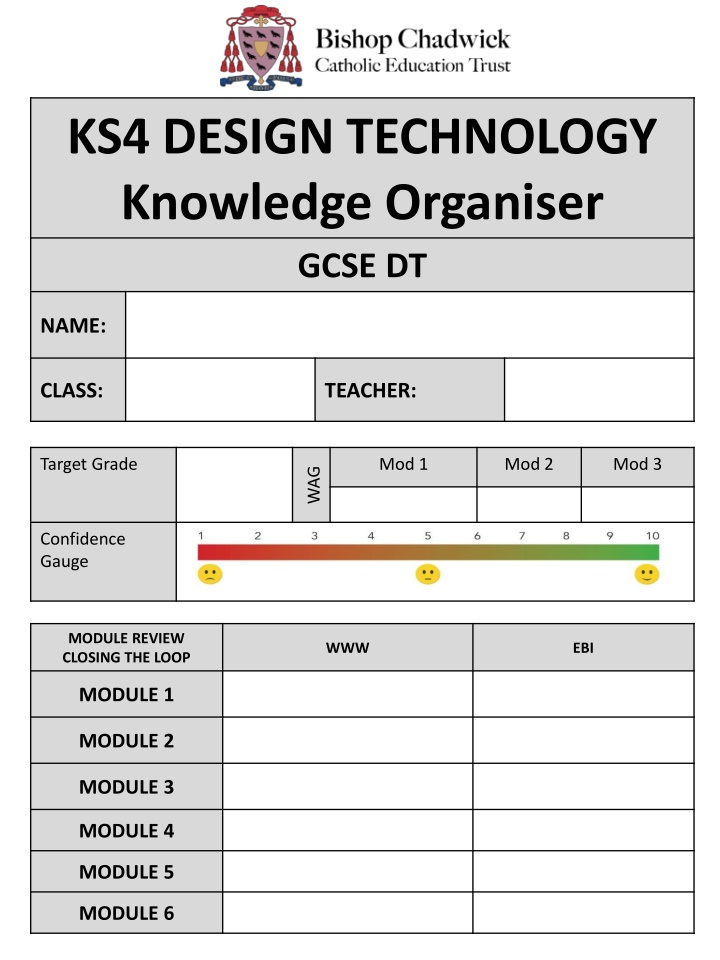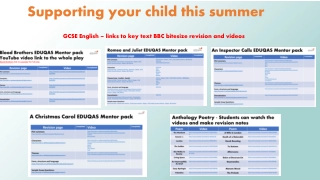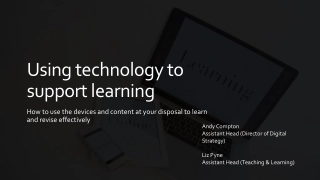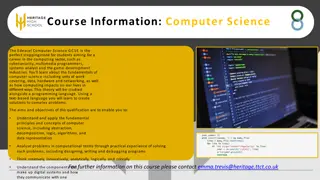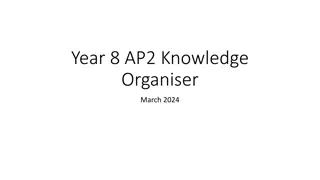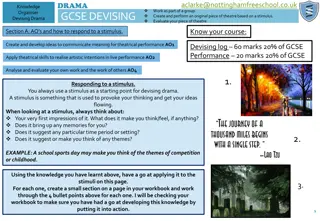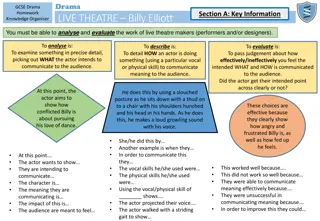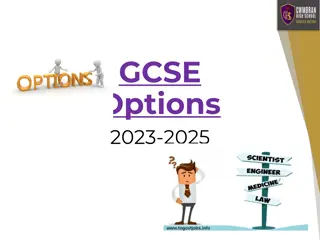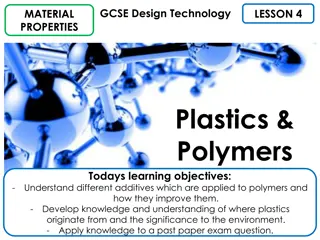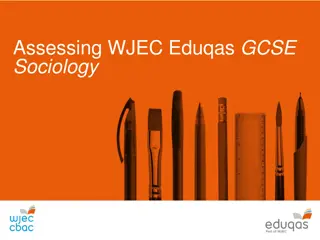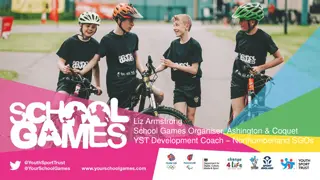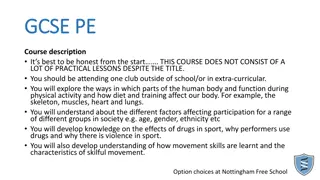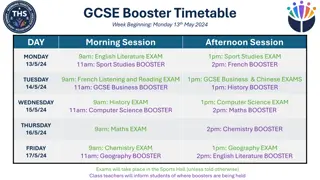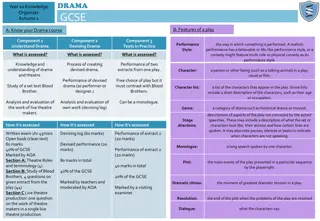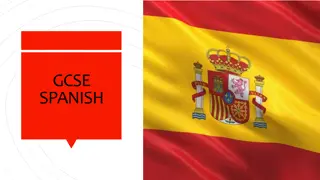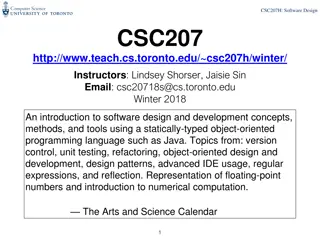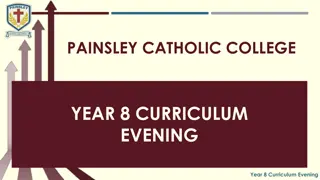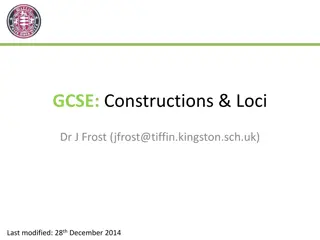GCSE Design Technology Knowledge Organiser and Course Structure Overview
In this detailed knowledge organiser, find information about the GCSE Design Technology course structure, learning objectives, mission statement, and core technical principles for KS4 students. The course emphasizes iterative design cycles, creative thinking, problem-solving, and addressing environmental challenges through inclusive design practices. Additionally, it includes details about the exam structure, design projects, reading recommendations, and career links.
Download Presentation

Please find below an Image/Link to download the presentation.
The content on the website is provided AS IS for your information and personal use only. It may not be sold, licensed, or shared on other websites without obtaining consent from the author.If you encounter any issues during the download, it is possible that the publisher has removed the file from their server.
You are allowed to download the files provided on this website for personal or commercial use, subject to the condition that they are used lawfully. All files are the property of their respective owners.
The content on the website is provided AS IS for your information and personal use only. It may not be sold, licensed, or shared on other websites without obtaining consent from the author.
E N D
Presentation Transcript
KS4 DESIGN TECHNOLOGY Knowledge Organiser GCSE DT NAME: CLASS: TEACHER: Target Grade Mod 1 Mod 2 Mod 3 WAG Confidence Gauge MODULE REVIEW CLOSING THE LOOP WWW EBI MODULE 1 MODULE 2 MODULE 3 MODULE 4 MODULE 5 MODULE 6
Intent, Implementation and Impact in KS4 Technology Our Mission Statement: We aim to use an iterative and explorative design cycle to empower students to become creative and critical thinkers. To find solutions to everyday problems that meet users needs and make the world a better environment for all in an inclusive way. What this means in your lessons: An iterative and explorative design cycle We want you to try to always be improving your ideas and looking for new solutions. Creative and critical thinkers We want you to think outside the box and challenge the ordinary designs you see every day. Solutions to everyday problems We want you to be the people who solve the challenges the world is facing through your new thoughts and exciting ideas. Meet users needs We want you to think about what your users need every step of the way so your design is human centred. Make the world a better environment We want you to help protect and improve the world for future generations to come. In an inclusive way We want you to design with an awareness of the challenges and barriers your customers may have.
Course Structure KS4 Design Technology AQA GCSE Design Technology 50% Exam (2 hours) Core Design and technology knowledge + questions on the specific materials studied + designing skills 50% NEA Design and Make project with a design portfolio and manufacturing skills.
Learning Journey 10-11 Design Technology Read like a designer Year 10: The New Science of Strong Materials or Why You Don't Fall Through the Floor J.E. Gordon Where Futures End Parker Peevyhouse Year 11: Success Through Failure: The Paradox of Design Henry Petroski Ready Player One Ernest Cline Careers Links Year 10: problem-solving, critical thinking, creative solutions, using systems and technology, communicating, working collaboratively, negotiating, influencing. Core technical principles New and emerging technologies Energy generation and storage Developments in new materials Systems approach to designing Year 11: self- management, adaptability, resilience, self-monitoring and development, active research, analytical and problem-solving skills Designing Basic sketching techniques Using primary and secondary data The work of other designers How to produce a specification Environmental, social and economic challenges Design strategies Materials Mechanical devices Materials and their working properties Material properties Making principles Communication of design ideas Prototype development Testing materials, processes and components Testing and evaluating Specialist principles Selection of material or components Forces and stresses Ecological and social footprint Sources and origins Modifying material Using and working with materials Stock forms, types and sizes Scales of production Tools & Equipment Specialist techniques and processes Surface treatments and finishes Project NEA Using a brief to create a design portfolio Evaluate and develop the design to the point of manufacture Use a range of processes to create a final product Revision Core principles Design Process Manufacturing processes and equipment Extra-curricular and enrichment Opportunities to enter Examinations Paper 1 Section A: Core technical principles Section B: Specialist technical principles Section C: Designing and making principles design competitions. Opportunities to visit national engineering and design events and examples of local industry To A level and beyond
Content KS4 Design Technology New and emerging technologies Automation and the use of robotics. Tools and equipment. Crowd funding, virtual marketing and retail, co-operatives, fair trade. How technology push/market pull affects choice. Changing job roles due to the emergence of new ways of working driven by technological change. Changes in fashion and trends in relation to new and emergent technologies. Respecting people of different faiths and beliefs. How products are designed and made to avoid having a negative impact on others: design for disabled, elderly, different religious groups. Positive and negative impacts new products have on the environment. Energy generation and storage How power is generated from: coal, gas, oil. Arguments for and against the selection of fossil fuels. How nuclear power is generated. Arguments for and against the selection of nuclear power. How power is generated from: wind, solar, tidal, hydro-electrical, biomass. Arguments for and against the selection of renewable energy. Kinetic pumped storage systems. Alkaline and re-chargeable batteries. Materials and their working properties Papers and board Natural and manufactured timbers Manufactured boards Metals and alloys Polymers Textiles Material properties Selection of materials and components Functionality: application of use, ease of working. Aesthetics: surface finish, texture and colour. Environmental factors: recyclable or reused materials. Availability: ease of sourcing and purchase. Cost: bulk buying. Social factors: social responsibility. Cultural factors: sensitive to cultural influences. Ethical factors: purchased from ethical sources such as FSC. Ecological issues in the design and manufacture of products Deforestation, mining, drilling and farming. Mileage of product from raw material source, manufacture, distribution, user location and final disposal. That carbon is produced during the manufacture of products. The six R's - Reduce, refuse, re-use, repair, recycle and rethink. Safe working conditions; reducing oceanic/ atmospheric pollution and reducing the detrimental (negative) impact on others.
Content KS4 Design Technology Developments in new materials Modern materials e.g. Graphene, Metal foams and Titanium. Smart materials - That materials can have one or more properties that can be significantly changed in a controlled fashion by external stimuli, such as stress, temperature, moisture, or PH e.g. shape memory alloys, thermochromic pigments and photochromic pigments. Composite materials - That composite materials are produced by combining two or more different materials to create an enhanced material e.g. glass reinforced plastic (GRP) and carbon fibre reinforced plastic (CRP). Technical textiles - How fibres can be spun to make enhanced fabrics e.g. conductive fabrics, fire resistant fabrics, Kevlar and microfibres incorporating micro encapsulation. Systems approach to designing Inputs - The use of light sensors, temperature sensors, pressure sensors and switches. Processes - The use of programming microcontrollers as counters, timers and for decision making, to provide functionality to products and processes. Outputs - The use of buzzers, speakers and lamps, to provide functionality to products and processes. Mechanical devices Types of movement - The functions of mechanical devices to produce linear, rotary, reciprocating and oscillating movements. Changing magnitude and direction of force - Levers: first order, second order, third order. Linkages: bell cranks, push/pull. Rotary systems: CAMs and followers, simple gear trains, pulleys and belts. Specialist techniques and processes How to use measurement/reference points, templates, jigs and patterns where suitable. A range of tools, equipment and processes that can be used to shape, fabricate, construct and assemble high quality prototypes, as appropriate to the materials and/or components being used including: Wastage, such as: die cutting, perforation, turning, sawing, milling, drilling, cutting and shearing. Addition, such as: brazing, welding, lamination, soldering, 3D printing, batik, sewing, bonding and printing. Deforming and reforming such as: vacuum forming, creasing, pressing, drape forming, bending, folding, blow moulding, casting, injection moulding, extrusion. Tolerance - the manufacture to minimum and maximum measurements. Commercial processes - Papers and boards (offset lithography and die cutting). Timber based materials (routing and turning). Metal based materials (milling and casting). Polymers (injection moulding and extrusion). Textile based materials (weaving, dyeing and printing). Electrical and mechanical systems (pick and place assembly and flow soldering).
Knowledge Organiser: KS4 Design Technology New and Emerging Technologies: Industry and Enterprise Key words Automation Crowdfunding Cooperative Enterprise Fair Trade Virtual Marketing Patent CAD CAM Automation This is when machines and robotics help make products or make them for you. Often this is done by CAD (Computer Aided Design) and CAM (Computer Aided Manufacture) This helps products be made quicker, with more accuracy. Reducing errors humans make to products. However, these machines are expensive to buy, need specialist training to use and need constant maintenance to keep them working properly Virtual Marketing This is when websites, social media and email are used to promote and sell products. This has become very popular in recent years, with big social media apps being funded by advertisers Companies can also pay search engines to push their company further to the top of the results page, so customers are more likely to click it. Cooperatives A Cooperative is an Enterprise that is run by members that are part of the workforce or customers. This means the organisation is democratic and often supports the local community. They are set-up to protect the rights of their members and ensure the same rules apply to everyone Curriculum Links Maths: Profit, time scale, planning, business Science: chemical and industrial processes. English: research skills and written communication ICT: word processing, flow charts, CAD Careers/ Cultural Capital: sectors and roles in DT, Enterprising ventures, analytical skills, Enterprise This is when an idea is developed into a business and produces a viable product. Often, one of the biggest enterprises are apps for smartphones. To make sure ideas are protected from being copied, a Patent can be applied for. This legally protects your idea or invention from being stolen. Crowdfunding This is where ideas are funded by large groups of ordinary people. www.Kickstarter.com is a good example of this. Fair Trade This is an organisation that promotes fair pay, working conditions and better trade with farmers in developing countries. You can tell when something is Fairtrade as it will often have the symbol on the product or packaging. Common Fairtrade items include; bananas, cotton and chocolate.
Knowledge Organiser: KS4 Design Technology New and Emerging Technologies: CAD CAM, JIT & Lean Manufacturing Key words CAD CAM Just In Time Lean Manufacturing CNC Router Automation 3D printer Laser cutter Application CNC Milling machine Prototype CAD Computer Aided Design Examples; 2D Design, Autodesk Inventor, Fusion 360, Photoshop, etc Advantages Disadvantages Easy to change designs Designs are easily saved and sent Can be worked on by multiple people simultaneously Can be used for virtual testing Can produce high-quality designs Complex and time-consuming to learn Expensive to buy PCs can crash or be hacked causing work to be lost Takes up PC memory CAM Computer Aided Manufacture Examples; 3D Printing, Laser Cutting, CNC Router, Automated Machines and Robotics, etc Advantages Disadvantages Expensive to buy the equipment, etc Training takes money and time Need specialists to maintain and repair the machines Dependence on CAM can cause unemployment Faster and more accurate than traditional tools Repetitive accuracy/ consistent outcomes Machines can run 24/7
Knowledge Organiser: KS4 Design Technology New and Emerging Technologies: CAD CAM, JIT & Lean Manufacturing Just-in-Time (JIT) Manufacture This is where manufacturers only order materials, parts, etc when needed. The customer s order triggers the production process and the resources needed for that order are the only ones bought. This can be used in any scale of production but is particularly useful for one-off production. Advantages Disadvantages Saves on warehouse and storage costs Money is not tied-up in stock Little/minimal waste Customer often pays in advance so money is secure before production All production stops if a part/material is missing Needs to have a fast, reliable and good quality supply chain to work properly Can be time-consuming Flexible Manufacturing Systems This is where automated machines are adaptable and can produce different products if needed. If a manufacturer is making a product with machines that are just dedicated to specific tasks they have to be reprogrammed and re-tooled before changing to a new task. This is time consuming and expensive. Lean Manufacturing Examples include; CNC Machines, 3D Printers, Laser Cutters, Robotic arms, etc This is where waste and energy is kept to a minimum. This helps manufacturers save money and resources in production, as well as helping minimise the environmental impact of producing products.
Knowledge Organiser: KS4 Design Technology New and Emerging Technologies: People, Society and Culture Key words Market Pull Technology Push Aesthetics Iconic design Inclusive design Exclusive design Evolution of design Trends Market Pull and Technology Push Technology Push is the development of new technology, materials and manufacturing methods to create new products or improve old ones. Examples include; Smart Phones, Electricity, Mass Production, etc . Market pull is the demand from consumers for new products and improvements in old ones; this is often found via reviews, polls, surveys, etc . Examples include; Product Aesthetics, making products easier to use, etc . Curriculum Links RE : Religion, Faith and Culture Cultures, Faith and Belief Different groups of people have different interests and have to be catered for. Different countries and cultures also react to products differently. E.g. In India McDonalds don t sell beef burgers as it has a large Hindu population, and cows are seen as sacred in contrast the UK sells its most amount of fish and chips on a Friday as it is a Christian tradition to not eat meat on that day.
Knowledge Organiser: KS4 Design Technology New and Emerging Technologies: People, Society and Culture Fashion and Trends Fashion and Trends will change quickly, and you can see major differences in fashions over decades. Designers have to make sure their products meet the fashion and trends of the area they are designing and selling the product to. The change of products over time is called Product Evolution. This is caused by Market Pull, Technology Push and Fashion and Trends. Some products are seen as timeless. These products are called Iconic Designs. These products are timeless because they were innovative, set a bench mark for following products, changed their industry and are often copied. Examples include; iPod, iPhone, Angle-Poise Lamp, Swiss Army Knife, Converse Shoes, Levi s Jeans, Classic Mini Cooper Inclusive vs. Exclusive Design Inclusive Design: The aim to create a product that as many people as possible can use Examples include; Cars, Doorframes, Adjustable Products, etc Exclusive Design: The aim to create a product for a particular group and their needs Examples include; Car seats for babies, Wheelchairs, Stair Lifts
Knowledge Organiser: KS4 Design Technology Energy Generation and Storage Renewable Energy Sources This is when certain sources of energy will not run out. Solar panels are used to collect light and convert it into electricity There is no waste and a consistent supply However, the panels are not effective at night or in countries where there isn t a lot of sunlight Solar Turbines harness wind energy Not effective on non-windy days Some people don t like turbines as they are noisy, and not attractive to look at Wind This harnesses energy from water held behind a dam Has to be created by flooding land damaging wildlife habitats Tidal energy comes from using energy from waves Hydro- Electrical This is fuel from natural sources e.g. crops, scrap woods and animal waste Growing biomass crops produces oxygen and uses up C02 However, is a very expensive method Biomass Non-Renewable Energy Sources This is when certain sources of energy will run out eventually Coal, Oil and Gas Burned to create steam, turned in turbines to create electricity. Burning creates C02 which adds to Global Warming Fossil Fuels Nuclear Fission controls the reactor (that creates the electricity). This requires Uranium which is non-renewable Accidents and waste can severely damage the environment and cause radiation poisoning Radiation poisoning can be fatal and cause physical deformations Nuclear waste has to be disposed of properly and is hazardous for thousands of years. Nuclear Power Storing Energy Pneumatics: This is the production of energy using compressed gas or air. E.g. Pistons in an engine Hydraulics: Like a Pneumatic system, but uses water or oil under pressure. E.g. Wheelchair lifts Kinetic: Energy that is generated by movement. This is stored by items like springs in a clickable pen or balloons. Batteries: Electrical power can be stored in batteries. Rechargeable batteries are becoming increasingly popular.
Knowledge Organiser: KS4 Design Technology Developments in new materials: Modern and Smart materials Smart Materials are materials that change and react to a stimuli Material Key info Examples Thermochromic Pigments Change colour in reaction to heat Kettles, baby bottles, etc Photochromic Pigments Colour changing glasses, windows, etc Change colour in reaction to light Returns to its original shape, in reaction to heat Shape Memory Alloy Braces and glasses Granules that once exposed to hot water, become a modelling material (like a dough or clay) Polymorph Modelling and repairs Modern Materials are materials that have been developed recently Material Key info Examples These are plant-based polymers that are a replacement for plastics that are biodegradable but cannot be recycled. Corn-starch Polymers Plastic bottles, tubs, food containers, etc Made in the same way as normal MDF but with grooves cut into the surface so it is flexible. Flexiply is the same but for Plywood. These can easily be shaped into curves Modern furniture, interior walls and room dividers Flexible MDF Prosthetics, medical applications, sports cars, etc High strength to weight ratio. Doesn t corrode or rust. Suitable for medical use as its hypo-allergenic Titanium Bullet-proof vests, tyres, helmets, etc Kevlar A woven polymer with a high strength to weight ratio.
Knowledge Organiser: KS4 Design Technology Papers and Boards Papers and Boards come from trees. The Stock forms for papers are: rolls, sheets, A4, A3, etc Material Key info Uses/ Examples Thick white paper, completely opaque and more expensive than photocopy paper Cartridge Paper Sketching, ink drawings Light, semi-translucent, good for blending inks and artist markers Sketching, drawing and some tracing Layout Paper Corrugated Cardboard Strong but light. Rigid triangles of card sandwiched between a top and bottom layer. Outer packaging, food packaging Cheap packaging. If waxy coating is applied, can be used for food Light card with white outside layers. Waxy coating can be added Duplex Board White card coated with a thin aluminium layer. Foil is great for insulation and water resistance Foil-lined Board Takeaway containers Solid White Board High-quality white card with a smooth finish. Stiff and holds colours well Greetings cards, packaging and advertising Key words Modern materials, Smart materials, Thermochromic, Kevlar, Nomex Photochromic, SMA, Bleed, Virgin paper Paper = > 200gsm Board = < 200gsm
Knowledge Organiser: KS4 Design Technology Key words Mechanical Devices Force Levers Mechanism Motion Linkages Gear trains Idler Pivot/Fulcrum Gear ratio = Gear driven divided by gear driver Curriculum Links Physics: Force, Levers, Mechanisms
Knowledge Organiser: KS4 Design Technology Mechanical Devices
Knowledge Organiser: KS4 Design Technology Materials and their working properties: Woods and Boards Key words Softwood Hardwood Man made Board Evergreen Deciduous Timber Grain Softwoods are generally cheaper than hardwoods as they are more available, since they grow quicker. But because man-made boards are manufactured they are cheaper than timbers. Man-made boards also come in a better variety of sizes since they don t depend on tree growth. Stock forms for both include; sheets, dowel, planks, etc Hardwoods come from Deciduous Trees. These trees loose leaves in winter and grow fruit and flowers in spring Material Key info Examples Sports equipment Tool Handles Ash Flexible, tough and shock resistant Toys, furniture and veneers Beech Fine finish, tough and durable Mahogany Easily worked, durable,high quality finish High-end furniture Balsa Very soft and spongy. Light Modelling Flooring, furniture and veneers Oak Tough, durable and hard Softwoods come from Coniferous Trees. These have thin, needle-like leaves and grow all year round. Often have pine cones and sometimes nuts and seeds Material Key info Examples Durable, tough, good water resistance and finishes well Furniture,flooring and used outdoors Larch Cheap furniture, construction and decking Pine Light, easy to work with but can split Furniture, musical instruments and construction Spruce Easy to work with, high stiffness but can decay quickly
Knowledge Organiser: KS4 Design Technology Materials and their working properties: Man made boards Manufactured boards are made from wood chips/dust/ layers and glue. Material Key info Examples Prone to chipping but good compressive strength. Not-water resistant Flooring, low-end furniture, flat-pack Chipboard Flat-pack furniture and kitchen unites MDF Rigid and stable. Easy to finish. Absorbs liquid easily Very stable. Exterior veneer can be used from more expensive woods Shelving, furniture, toys Plywood Primary Processing of Papers and Boards Trees are cut then converted into planks by sawing It is then seasoned to reduce the moisture in the wood. This is done by either: Air-drying Planks are stacked and air allowed to circulate; causing evaporation Kiln-drying Where planks are put into a kiln and dried rapidly. This process is more costly than air-drying Manufactured boards can be either be made by lamination or compression Lamination Layers of woods and adhesive are layered and compressed together. Usually with a more expensive wooden veneer on the top Compression Wood is shredded, heated and compressed with adhesive under extreme pressure We remember Softwoods with this acronym - Soft Little Prickles
Knowledge Organiser: KS4 Design Technology Materials and their working properties: Metals and Alloys Key words Ferrous Non Ferrous Rust Magnetic Alloys Metals come from ores in the ground. Stock forms are sheets, bars and rods Ferrous Metals contain iron and are magnetic and rust Material Key info Examples Low Carbon Steel Tough and ductile and easily machined and welded Construction, screws, cars High Carbon Steel Hard and wears well Tools, blades and knives Cast Iron Hard but brittle. Easily cast but hard to machine Pots, pans, vices Non-Ferrous Metals do not contain iron, aren t magnetic and don t rust Material Key info Examples Aluminium Light, high strength to weight ratio and ductile Pots, pans, cars, cans Copper Ductile, malleable and good conductor Plumbing supplies and cables Tin Soft, malleable and good conductor Used as a protective coating Alloys are mixtures of 2 or more metals to get the best of their properties Material Key info Examples Brass Malleable and easy to cast Musical instruments, plumbing Stainless Steel Doesn t rust, hard and smooth Cutlery, medical tools, etc
Knowledge Organiser: KS4 Design Technology Materials and their working properties: Plastics Plastics come from crude oil. Stock forms are sheets, powders, granules and rods Thermoplastics can be reheated and reshaped an infinite amount of times Material Key info Examples Bottles, packaging, etc PET Easily blow moulded, food safe and easily recycled PVC Flexible, tough, easily extruded Pipes, tape, hard hats Flexible, lightweight, food safe and easily vacuum formed Containers and yoghurt pots HIPS Car lights, baths, displays/ signs Acrylic Tough, brittle, easily scratched Thermosets once heated and set cannot be reshaped Material Key info Examples Melamine Formaldehyde Kitchenware and work surfaces Food safe, hygienic, hard and brittle Urea Electrical casings, buttons and handles Good insulator, hard and brittle Formalehyde Polyester Resin Strong, heat resistant, can be transparent Coatings, casings Primary Processing of Metals and Alloys Primary Processing of Plastics Metals are mined from the earth and then go through an extraction process. Extraction happens by putting the ore in a blast furnace. The metal is then separated from the waste material. Crude oil is extracted from the earth and then processed into different types of fuels, etc. This is called Fractional Distillation. A process called Cracking then converts the large hydrocarbon molecules into plastics.
Knowledge Organiser: KS4 Design Technology Ecological issues in the design and manufacture of products Key words Ecological Renewable Sustainable Deforestation 6Rs Product Airmiles Carbon Footprint Disposal Pollution Finite Obsolescence The 6Rs Meaning To use a product again either for the same purpose or a different one Reuse To have less of material/packaging/pollution when making products by making them more efficient Reduce Recycle Breaking down and forming the material into another product Customers not buying or supporting products that make an environmental impact Refuse Designers and customer rethinking their decisions when making and buying products. Rethink Fixing a product rather than throwing it away. Extending its life rather than using more resources to make another Repair Often products are Designed for Maintenance so can easily be repaired. E.g. Using screws so even non-specialists can take a product apart, or using components that can easily be replaced like fuses or batteries Life Cycle Assessment Curriculum Links This is when a designer looks at the environmental impact a product makes over its life time and how it could be reduced. Including: Geography : Landfill, airmiles, carbon footprint Impact of materials Impact of processes Product Miles (how far a product has to travel to get from factory to consumer) Impact while in use Impact when disposed of (6Rs)
Knowledge Organiser: KS4 Design Technology Ecological issues in the design and manufacture of products Key knowledge Repairing products rather than throwing them away Reducing Product Miles by making the product in the country it is sold in Planting more trees to reduce deforestation What can we do to reduce environmental impact of products and their manufacture? Reducing Pollution by using less plastics, efficient manufacture, less waste and using renewable energy (like solar and wind) Recycling products and materials Using less finite resources Sustainability is maintaining our planet and its resources and making a minimal negative impact Finite Resources Will run out of eventually Infinite Resources Can be re-grown and renewed. Will not run out Plastics Paper Metals Boards Polymers (Textiles) Natural Timbers Cotton Leather This is where products die after a certain amount of time. E.g. Disposable cups, Phones, Lightbulbs, Printer Ink, etc This can have a big environmental impact as customers are throwing away lots of products, and resources are being used to create new ones. Planned Obsolescence
Knowledge Organiser: KS4 Design Technology Scales of Production Name/ Type How many it makes Examples of Products Key Info Also known as Bespoke or Prototype manufacture Custom-made products Specialist workers/ skills Specialist machines and materials High Quality but expensive Towers / Bridges One-off Houses Wedding rings One-off Production 1 Uses a mix of workers and machinery Uses jigs, moulds and templates to help make identical products Stations of workers e.g. cutting station, painting station, etc Can have some variation e.g. colour, finish, flavour Baked foods Limited edition car Socks Chairs Batch Production 10s-1000s Big assembly lines (and sub-assembly lines) Heavily automated Standard and identical products Little worker input Cars Bottles Microchips Plain shirts 10,000s - 100,000s Mass Production Energy Water Paper Plastic 24/7 production Heavily automated Standard and identical products Little worker input Continuous Production 100,00s +
Knowledge Organiser: KS4 Design Technology Scales of Production One-off Production Advantages Disadvantages Custom made High Quality Materials High Quality Craftsmanship Time consuming Specialist training for workers Expensive to buy Mass Production Advantages Disadvantages Initial starting costs are high If production line stops, the product can t be made Workers become bored monitoring machines and repetitive tasks Large amounts made at once All products are identical and to same standard Using automation reduces human error Batch Production Advantages Disadvantages Lower cost than one-off Jigs, moulds and templates help products look identical Can have some variety High storage costs Jigs, moulds and templates have to be checked Workers can become bored on their station Continuous Production Advantages Disadvantages Initial starting costs are high If production line stops, the product can t be made Workers become bored monitoring machines and repetitive tasks Large amounts made at once All products are identical and to same standard Using automation reduces human error
Knowledge Organiser: KS4 Design Technology Specialist Techniques: Production Methods Name of Process Diagram Material Products Made Screen- printing Posters, signs and t-shirts Papers and Textiles Papers and card (thin, flexible plastics) Posters, newspapers, plastics bags Offset Lithography Chair legs, baseball bats (cylindrical items) Lathe Turning Wood and metal Die Car parts, engine components, etc Metal Casting Injection Moulding Plastics Chairs, toys, etc Blow Moulding Plastics Plastic bottles
Knowledge Organiser: KS4 Design Technology Specialist Techniques: Production Methods Name of Process Key info Screen printing places paint on top of a screen. The screen has a stencil embedded in it, so when the paint is passed across it the desired shape is printed underneath. Good process in one-off and batch production as often done by hand Screen- printing Rollers containing the colours and water go onto the plate cylinder. The water stops the colours sticking to certain places, creating the shape. The shape is transferred between rollers and onto the material. Can be used for batch and mass production Offset Lithography Material is placed between the tail stock and the headstock and spun at high speed. The material is then cut using specialist tools (either by hand or by automated machinery) to the desired shape. Can be used in one-off and batch production Lathe Turning Molten metal is poured into a chamber and a plunger forces the metal through the nozzle into the mould. Unlike sand casting, the mould is reusable. Good process for both one-off and batch production Die Casting Plastic granules are poured into the hopper and onto the screw. The screw moves the material towards the heater where it turns into a liquid. The liquid is then forced into the mould, cooled and released. Great process for mass production as it makes 100s+ of products at once, to an identical standard. Injection Moulding A Plastic parison is heated and put into the mould. The parison is then filled with air (like blowing up a balloon) and is forced to fit the mould shape. It is then cooled and then released. This is a great process for mass producing bottles. Blow Moulding
Knowledge Organiser: KS4 Design Technology Specialist techniques and processes: Finishes and standard components Finishes are used to improve the aesthetics and durability of products Material Type Finishes Used Paints Varnishes Laminating Plastic coating Wax coating Papers and Boards Paints Varnishes Wax and Polish Staining Oil Timbers and Boards Polishing Plastic Coating Powder Coating Painting Lacquering Electroplating Galvanzing Metals and Alloys Polishing Painting Decals (stickers) Plastics Standard Components Standard components are parts or components manufactured in the 1000s+ They are readily available, don t require specialist knowledge or tools to replace them, they are cost effective and are universally recognised Material Type Components used Staples Clips Split pins Papers and Boards Nails Screws Timbers and Boards Nuts and bolts Screw Panel Pins Hinges Rivet Washer Metals and Alloys Plastic hinges Plastics
Knowledge Organiser: KS4 Design Technology Specialist techniques and processes: Tolerances and Process Orders Tolerances The total amount a specific dimension or property is permitted to vary This can apply to hole depth, length, angle, thickness, weight and elasticity A gauge can be inserted into a gap or hole to check if the sizes fall within tolerance If parts do not fit within the specified tolerances they are discarded or recycled Quality Control and Quality Assurance QC is product oriented Quality control is where products are regularly tested (during and after manufacture) to ensure they meet the defined set of quality criteria QA is process oriented Quality assurance is ensuring that the processes used to test the product have been done correctly and consistently You can test a product all you like, but if the tests are wrong/ inconsistent with each other than the results are invalid Below are examples of Quality Assurance symbols: European Conformity Registration Mark BSI Kitemark Lion Mark Process Orders An Output is a response to the stimuli A Process is an action of transforming information into an Output An Input is information/ stimuli that enters a PC An example would be speakers, text on a screen, alarm, lights, etc An example would be keyboard, sensor, mouse, etc An example would be a PC
Knowledge Organiser: KS4 Design Technology The Work of Others Image/ Example Designer Design Movement Key info British designer in 1880s Simple natural crafts Useful and beautiful products (wallpapers, cushions, etc) Arts and Crafts William Morris Scottish designer in 1860s 1920s Known for light and shadow Created stained glass and furniture Inspired by nature and geometric lines Charles Rennie Mackintosh Art Nouveau Italian designer in the 1950s/60s Enjoyed making everyday objects wacky and bold Used lots of bold colours and black lines Ettore Sottsass Memphis Image/ Example Brand Key info Italian Design Company Homeware and kitchen utensils Post-modern style Philippe Starck is a major designer Alessi USA-based tech company Famous for iconic designs of iPod and iPhone Steve Jobs and Johnathon Ive are major designers Known for innovative and modern design Apple British engineering company Famous for vacuum cleaners and innovative technology James Dyson is a major designer Dyson
Knowledge Organiser: KS4 Design Technology The Work of Others Case studies Product Analysis Interviews What methods of research can be used to find information? Questionnaires and surveys Materials testing Social media and email Research can be divided into 2 categories; Primary Research and Secondary Research. Primary is research you complete yourself. Secondary is research from resources others have gathered e.g. books, magazines and internet Primary research is generally more reliable as it is done by the person using it and can double-check the data Another key piece of research, is Anthropometrics and Ergonomics. This helps develop the sizes of products, etc to make sure it fits the User The study of measurements of the human body. Anthropometrics E.g. Knowing the grip width of a palm, if designing a new travel coffee cup The application of anthropometrics to ensure products are safe and comfortable to use. This can also include; size, material, appearance, brightness, sound and texture. Ergonomics E.g. making sure the travel cup is the correct size, and an insulating smooth material to make it comfortable to hold for long periods
Knowledge Organiser: KS4 Design Technology Design Strategies Design Strategies are used to solve Design Fixation, and help develop creative design ideas. Iterative Design A Proposal is made It is then planned and developed to meet the brief It is analysed and refined It is then tested and modelled Then evaluated against the brief many versions fail but that then informs development to make the idea better The cycle then repeats and if the product is successful it is then made and sold on the market Iterative Design Advantages Disadvantages Consistent testing helps solve problems earlier Constant feedback Easy evidence of progress Designers can loose sight of the big picture Time consuming User-Centred Design This is when designs are based on fulfilling the needs and wants of the Users/ Clients at every stage of the design process Questioning and testing is ongoing and is often found through interviews, questionnaires, surveys, etc User-Centred Advantages Disadvantages Requires extra time to get customer feedback If focused on just one person it can limit appeal to others User feels listened to Makes sure the product meets their needs
Knowledge Organiser: KS4 Design Technology Design Strategies Systems Approach Usually used for electronic products Often uses diagrams to show systems in a visual way Planning the layout for the correct sequences e.g. inputs, outputs, timings, etc Electronics and mechanical systems need an ordered and logical approach Systems Approach Advantages Disadvantages Does not need specialist knowledge Easy to communicate stages Easy to find errors Sometimes over-simplifies stages Can lead to unnecessary stages Collaborative Approach Working with others to share data and solving problems and coming up with design proposals can help with creativity Numerous companies work in teams, and has been shown to improve the range and quality of ideas produced Collaborative Approach Advantages Disadvantages Gets multiple opinions and a range of views Working in groups can produce more ideas Can be difficult to design ideas with opposing views Can be difficult to find time to communicate with multiple people
Knowledge Organiser: KS4 Design Technology Communication of Design Ideas Design Briefs A Design Brief is the statement of how you will solve the Design Problem It will often include: Constraints/ limitations What the product is Materials/processes Any key information you know Design Specifications A Design Specification is a list of requirements your product has to meet in order to be successful It is also useful for evaluation. If your product hasn t met the Spec then it gives you a starting point for improvements. What the product looks like? Style? Colour Scheme? Design Movement? Aesthetics Who would buy it? (Age, gender, socio-economic, personality) How does the design appeal to them? Customer Cost How much will it cost? (min-max) Why? Environment Where will it be used? Why? How will you make it suitable? Safety How is it safe? How will it be checked? Why must it be safe? Size What is the maximum or minimum size? Why? What does the product do? What features make it do that function well? How is it unique from similar products? Function Materials What is it made from? Why? Manufacture How might it be made? Why? What scale of production? Why?
Knowledge Organiser: KS4 Design Technology Communication of Design Ideas Technique Description/ notes Diagram Includes Front , Plan and End 2D Views, and often an Isometric 3D View Standardised method for scale, dimensions and line types Great for manufacturing Orthographic Projection/ Working Drawings Common 3D sketching method Can be drawn free-hand or using isometric paper and ruler Angles are at 30 degrees Great for seeing most of the products Isometric A 3D drawing method Often used by interior designers and architects Gives drawings depth Only uses 1 vanishing point 1-Point Perspective Used for 3D designs Exaggerates the 3D effect Objects can be drawn above or below the horizon line but must go to the 2 vanishing points 2-Point Perspective Quick and easy way of getting ideas down Range of ideas can be seen Annotation helps explain designs further Annotated Drawings/ Free and Sketches Helps see a final design of a product and all its parts Can see where all the parts fit Great for manufacturers Exploded View Modelling and Development Modelling and development are key to testing and improving products This can be done physically using materials like; card, foam, clay, man-made boards or virtually in CAD Modelling helps the designer get feedback from the customer, check aesthetics, function, sizes and even materials and production methods and change them if needed
Knowledge Organiser: KS4 Design Technology Revision Topics Checklist Scales of Production Research and Investigation Developing and Communicating Ideas Revised Revised Revised Exam Question Exam Question Exam Question Revised again Revised again Revised again Production Methods Prototyping and Development Briefs and Specs Revised Revised Exam Question Revised Exam Question Revised again Exam Question Revised again Tolerances Revised again Designing Products Process and Manufacture Revised Exam Question Revised again GCSE DT Work of Others People, Society and Culture Revision Revised Revised Topics Exam Question Exam Question Revised again Approaches to Design Revised again Industry and Enterprise Environment Design Strategies Revised Revised Revised Exam Question Exam Question Exam Question Revised again Revised again Revised again
Knowledge Organiser: KS4 Design Technology Materials Standard Components and Stock Forms Paper and Boards Finishes Energy and Mechanisms Revised Revised Exam Question Process Orders Revised Exam Question Revised again Exam Question Revised Revised again Revised again Exam Question Plastics Revised again Woods and Boards Revised Revised Mechanical Systems Exam Question Exam Question Revised Revised again Revised again Exam Question New and Smart Materials Properties of materials Revised again Revised Revised Energy Generation and Storage Exam Question Exam Question Maths and Science Revised again Revised Revised again Exam Question Angles Energy Revised again Revised Revised Exam Question Exam Question Maths & Science Revised again Revised again GCSE DT Environment Decimals Forces Revision Revised Revised Revised Topics Exam Question Exam Question Exam Question Revised again Revised again Revised again Ratios, Fractions and Percentages Area and Volume Charts and Graphs Revised Revised Revised Exam Question Exam Question Exam Question Revised again Revised again Revised again
Structuring your answers in Design Technology P.E.E Chains In Technology we use PEE chains to expand our answers so we are communicating our thoughts and ideas clearly. This makes sure that we say what we think and then back up, or justify, our thoughts with explanations and evidence from research which support them. POINT Say WHAT you think. I think the product should be EXPLAIN Say WHY you think it. This is because EVIDENCE Say what RESEARCH you ve done to back this up. I know this from my research into ACCESS FM ACCESS FM is an analysis and annotation tool which makes sure we consider all the important design criteria and the impact they have on products we are investigating, designing or evaluating, Appearance Where did the designer get their inspiration? Could the product look better? Do you think it looks attractive or ugly, Why? What does the product look like? THINK shape, form, materials, size, beauty, ugliness. A Is it affordable to your customer? Will it make a profit? Is it value for money? How much does it cost to make? Cost C Customer What impact would it have on a customers life? Why would a customer buy it? What makes it suitable for them? Who would buy it? Who would use it? C Environment What is the products impact on the environment? THINK batteries, rethink, refuse, reduce, reuse, recycle, lifecycle. How would the product be disposed of? Is the product needed or wanted? How long will it last? E Safety Is the product high quality? Does it meet safety standards? How has the designer considered safety? Could the product hurt anyone? Are there any sharp edges? S Is it an appropriate size? Would it work better if it was bigger or smaller? Does it come in different sizes? How big is it? Size S Function Does the product work? Could the product work better? How does the product work? Why is the product needed? What does the product do? Is it easy to use? F Manufacture Materials/ What impact could the designer s choice of material have on the environment? Would a different material make it better? What material has it been made from? What process would be used to make it? M
Structure Strips in Design Technology State 2 marks Example Question State two reasons why corrugated cardboard is used as packaging for cooked pizzas. 1 Reason 1 (1 mark) It is a rigid material that won t flex and bend as easily as other types of cardboard which offers protection to the pizza. 2 Reason 2 (1 mark) The thermal properties of the material, as cavities in the cardboard keep the pizza warm. Give 2 marks Example Question In 2010 the use of renewable energy in the UK accounted for 6.5% of total energy usage. By 2015 this figure had increased to 25%. Give two reasons for the increase in the use of renewable energy sources. 1 Reason 1 (1 mark) The Government set specific targets to reduce CO2 emissions. 2 Reason 2 (1 mark) People now have an increased awareness of environmental issues and are more conscientious about them. Describe 4 marks Example Question Describe two ways that materials and/or products are strengthened or reinforced. Give examples in your answer. 1 Description 1 (1 mark) Layering materials can make materials stronger as you can lay them with their grain in different directions. This ensures the weak lines of the grain are strengthened. 2 Example (1 mark) Plywood is created in layers to strengthen the material. 3 Description 2 (1 mark) Laminating is adding a plastic coating to a material to make it more rigid, tougher and weather resistant. 4 Example (1 mark) Plastic coating is added to card and paper to make the materials more wear resistant and rigid, for example a restaurant menu.
Explain (written) 4 marks Example Question Explain what is meant by the term anthropometrics and why it is important for designers to consider. 1 Define key word (1) Anthropometrics is the study of human measurements. 2 Give 3 reasons why (3) Designers need to consider anthropometric data in order to: ensure that wearable items fit ensure that products are comfortable ensure that products are easy to use Explain (notes and sketches) 6 marks Example Question Name one industrial process used in the manufacture of a polymer toy musical instrument. In the box below, use notes and/or sketches to explain this process in detail. 1 Identify (1) A suitable process would be Injection Moulding 2 Describe (2) A polymer is placed in the hopper and enters the chamber of the injection moulding machine. The chamber is heated until the plastic melts. The plastic is then forced in to a mould where it cools to create the shape of the object. 3 Sketches to help with description (2) Sketch of injection moulding machine and movement of plastic. 4 Explain why (1) Injection moulding is suitable because it is quick and cheap for mass produced parts and it does not require finishing. Evaluate 4 marks Example Question Evaluate the Apple watch in terms of its suitability for the user. 1 Positives / Advantages (1-2) Waterproof which allows for use when outdoors and does not absorb sweat. Clear display screen which is easy to read even when moving. 2 Negatives / Disadvantages (1-2) Flat screen susceptible to reflection Screen can scratch easily 3 Summary (1) Overall the watch is well suited to the user as it has a range of specific features which are suited to the environment in which it will be used and the negative design features are minimal.
Justify 8 Marks Example Question Justify the design decisions which have been made to make the Apple watch more aesthetically appealing and gender neutral for the user. Q: 1 Identify / underline each key word Aesthetically appealing Gender neutral 2 Define each key word (2) An aesthetically appealing product is one which looks attractive to its specific target market. A gender neutral product is not aimed specifically at one gender, but it may have options to target each gender. 3 Promote Positives / Advantages (2) Black in colour which is neutral and sophisticated which will appeal to an adult target market. A plain colour that will not date/go out of fashion and appropriate for a wide range of settings Brightly coloured icons on the screen that are attractive and easy to recognise Geometric, simple styling that can be worn by men or women. 4 Discount Negatives / Disadvantages (2) Black is a boring colour that will not excite, but you can purchase alternative straps to make it more personalised. Square shape face may not appeal to all users or may appeal masculine, however, this has featured on previous products and they have sold well. 5 Summary (2) Previous sales show that the latest Apple watch is appropriate for the target market as it sells in high volumes. As it can be personalised through different straps, the customer can tailor the watch to their personal style which makes it more aesthetically appealing to them and the original watch being gender neutral allows this to be done effectively.
Evaluate 10 marks Example Question Designers sometimes choose materials according to their impact on society and the environment. Examples include the use of fair trade cotton, recycled components and biodegradable packaging. Evaluate how the use of such materials might be seen as the ethical choice. 1 Identify / underline each key word Biodegradable Packaging Fair trade Cotton Recycled components Ethical choice 2 Define each key word (3 marks) Biodegradable Packaging is made from materials which decompose much more quickly so that less waste is left in landfill Fair trade Cotton is produced by cotton farmers who are paid a living wage which allows them to survive and earn enough money to feed their families Recycled Components are made from waste products where the material has been melted down and reformed. An ethical choice is one which avoids harm to people, animals and the environment. 3 Positives / Advantages (3 marks) Biodegradable packaging: Require less energy to process into a useable material. Are easier to recycle/use less energy to recycle. Are non-toxic when they break down. Fair trade Cotton: Ensures workers / farmers get a fair price for their labour / products. It gives small scale farmers access to global markets. Buying this product shows your support for these communities. Recycled components: Often contain valuable materials such as gold, copper, aluminium. Saves landfill space. 4 Negatives / Disadvantages (3 marks) Biodegradable packaging: Are relatively new materials and not currently widely used. May be more expensive. Fair trade Cotton: Paying a higher wage results in products having a higher overall cost/price. Recycled components: Are non-renewable and are becoming more difficult and costly to find. 5 Summary (1 mark) Overall, the main disadvantage of choosing these materials seems to be cost. However, I think that they are ethically right as they reduce the impact on the environment and are more socially acceptable as well and I think this is more important than the fact that products will be more expensive.
Oracy in Design Technology Oracy means being able to express yourself clearly using spoken language. We build oracy tasks into Technology lessons to help you develop the technical language and understanding that you need to be able to communicate your ideas and opinions effectively to others. These are some of the activities which we use in lessons, but you can try them out at home too! RANT You need to discuss and explain all the negatives you can think of on the topic you have been given. Success Criteria Consider all the potential negatives State your opinion clearly Take turns with your partner / group Explain your reasons Give examples Don t lose your temper! Sentence Starters The problems are I disagree with you because The effects of that are That s true but have you considered I hear what you are saying but RAVE You need to discuss and explain all the positives you can think of on the topic you have been given. Success Criteria Consider all the potential positives State your opinion clearly Take turns with your partner / group Explain your reasons Give examples Be enthusiastic! Sentence Starters The benefits of this are I feel this is positive because The effects of that are That s true but have you considered I hear what you are saying but Talk Detective You need to observe conversations and identify examples of good oracy. Success Criteria Look for what people are doing well Record specific phrases and names Give praise in your feedback Use positive body language when you feedback TalkDetective Things to look for: Invited someone else to contribute Challenged someone's opinion Summarised their thinking or the group opinion Clarified someone s idea Gave a good example Used appropriate body language Used technical language / key words
Revision Strategies in Design Technology Used Technique Revision Cards Memory Map Challenge Difficulty Hard Challenge Description Write out flash cards which have questions on the front and answers on the back which can be used for testing yourself/each other. Mind map all the key points and key words related to the topics. Use images as appropriate. Use the first letter of key words to spell out a word or phrase to remember lists or large chunks of information e.g. Richard of York gave battle in vain (colours of the rainbow: red, orange, yellow, green, blue, indigo, violet) or ACCESS FM. Use flash cards or the practice questions in the book to test your knowledge of topics. mnemonics Hard Challenge Self Test Challenge Hard Challenge Extreme Challenge Designing your own question and mark scheme for the topic Create a model answer for the question you designed. Smartass Lists Extreme Write down impressive/unusual key words or expressions which you could use to answer a question on that topic Make up an example exam question on the topic and write a mark scheme for it using the revision guide. Then test a peer with the question, mark their work and work in pairs to develop the mark scheme. Write a poem or a rhyme (you could even include a tune) which will help you to remember the key words or points for a topic. Draw images surrounded by key words which will remind you of the key information or help to summarise the topics. This may be a single image (e.g. materials/tools) or a story board (e.g. processes) Number or bullet point the key information on a topic. Try and list them in order of importance. Create an audio account of the key information which you can then play back to yourself to help you remember the key points. In pairs write and record an interview which includes the key information about a topic and requires the interviewee to explain and justify the information being covered. Challenge Example Q&A Hard Challenge Songs/Poems Hard Challenge Challenge Pictograms Bullets/Lists Challenge Audio Tape Challenge Hard Challenge Physical Map Challenge Put key points about a topic around the room. Move to that point and either read out loud or write down the fact/point/information. This means that the information then becomes associated with this specific place and thinking about the place should trigger the recall of information. In teams of 3-4, take it in turns to relay the information about a topic until you run out of key points. Then check that you covered all the information by using the revision guide/notes as a checklist. Create quiz, quiz, trade cards and use them in small groups to cover the information for a topic. Each card should feature a question and a sub-question or hint on one side, with the answer on the reverse. Talk in pairs andcover the main points of a topic (make a note of what you remember together in your revision books) Then pair up with someone else and add to you notes, repeat this until you think you have all the information then check against the revision guide. Similar to Talk, Pair, Share - working in teams of 3-4 cover the main points of a topic (make a note of what you remember together in your revision books) and then move teams and add to you notes, repeat this until you think you have all the information then check against the revision guide. Useful for key words. Independently define a key word, then in teams of 3-4 bring definitions together and synthesise the information to create the best definition possible. Can also be used to develop responses to exam questions. Challenge Round Robin Quiz Quiz Trade Hard Challenge Talk Pair Share/speed dating Hard Challenge Talking Tables Challenge Consensus Hard Challenge
Personalised Learning Checklist: KS4 Design Technology Create a revision aid for each of the statements below, to prove you can do each one. If you can definitely do the full task, tick green. If you can do some of the task, tick amber. If you can do less than half of the task, tick red. If you have not ticked green, spend some extra time revising that area! What s a revision aid? This could be revision notes, a mind map, a list, flashcards. Whatever works for you! Look at the revision strategies page for more ideas. GCSE DT REVISION PLC Topic R A G New and emerging technologies The design and organisation of the workplace including automation and the use of robotics Buildings and the place of work. Tools and equipment. Enterprise based on the development of an effective business innovation: crowd funding, virtual marketing and retail, co-operatives, fair trade. The impact of resource consumption on the planet: finite, non finite, disposal of waste. How technology push/market pull affects choice. Changing job roles due to the emergence of new ways of working driven by technological change. Changes in fashion and trends in relation to new and emergent technologies. Respecting people of different faiths and beliefs. How products are designed and made to avoid having a negative impact on others: design for disabled, elderly, different religious groups. Positive and negative impacts new products have on the environment: continuous improvement, efficient working, pollution, global warming. The contemporary and potential future use of: automation, computer aided design (CAD), computer aided manufacture (CAM), flexible manufacturing systems (FMS), just in time (JIT), lean manufacturing. That it is important to consider scenarios from different perspectives and considering: planned obsolescence, design for maintenance, ethics, the environment. Target Topics:
GCSE DT REVISION PLC Topic R A G Energy generation and storage How power is generated from: coal, gas, oil. Arguments for and against the selection of fossil fuels. How nuclear power is generated. Arguments for and against the selection of nuclear power. How power is generated from: wind, solar, tidal, hydro-electrical, biomass. Arguments for and against the selection of renewable energy. Kinetic pumped storage systems. Alkaline and re-chargeable batteries. Developments in new materials Modern materials - Developments made through the invention of new or improved processes e.g. Graphene, Metal foams and Titanium. Alterations to perform a particular function e.g. Coated metals, Liquid Crystal Displays (LCDs) and Nanomaterials. Smart materials - That materials can have one or more properties that can be significantly changed in a controlled fashion by external stimuli, such as stress, temperature, moisture, or PH e.g. shape memory alloys, thermochromic pigmentsand photochromic pigments Composite materials - That composite materials are produced by combining two or more different materials to create an enhanced materiale.g. glass reinforced plastic (GRP) and carbon fibre reinforced plastic (CRP). Technical textiles - How fibres can be spun to make enhanced fabrics e.g. conductive fabrics, fire resistant fabrics, kevlar and microfibres incorporatingmicro encapsulation. Systems approach to designing Inputs - The use of light sensors, temperature sensors, pressure sensors and switches. Processes - The use of programming microcontrollers as counters, timers and for decision making, to provide functionality to products and processes. Outputs - The use of buzzers, speakers and lamps, to provide functionality to products and processes. Mechanical devices Types of movement - The functions of mechanical devices to produce linear, rotary, reciprocating and oscillating movements. Changing magnitude and direction of force - Levers: first order, second order, third order. Linkages : bell cranks, push/pull. Rotary systems: CAMs and followers, simple gear trains, pulleys and belts. Target Topics:
GCSE DT REVISION PLC Topic R A G Materials and their working properties Papers and board - You should have an overview of the main categories and types of papers including: bleed proof, cartridge paper, grid, layout paper, tracing paper boards including: corrugated card, duplex board, foil lined board, foam core board, ink jet card, solid white board. Natural and manufactured timbers You should have an overview of the main categories and types of natural and manufactured timbers: hardwoods including: ash, beech, mahogany, oak, balsa softwoods including: larch, pine, spruce manufactured boards including: medium density fibreboard (MDF), plywood, chipboard. Metals and alloys You should have an overview of the main categories and types of metals and alloys: Ferrous metals including: low carbon steel, cast Iron, high carbon/tool steel. Non ferrous metals including: aluminium, copper, tin, zinc alloys including: brass, stainless steel, high speed steel. Polymers You should have an overview of the main categories and types of polymers: Thermoforming including: acrylic (PMMA), high impact polystyrene (HIPS), high density polythene (HDPE), polypropylene (PP), polyvinyl chloride (PVC), polyethylene terephthalate (PET) Thermosetting including: epoxy resin (ER), melamine-formaldehyde (MF), phenol formaldehyde (PF), polyester resin (PR), urea formaldehyde (UF). Textiles You should have an overview of the main categories and types of textiles: natural fibres including: cotton, wool, silk synthetic fibres including: polyester, polyamide (nylon), elastane (lycra) blended and mixed fibres including: cotton/polyester woven including: plain weave non-woven including: bonded fabrics, felted fabrics knitted textiles including: knitted fabrics. Material properties - In relation to the main categories outlined above (not the specific materials identified), students should know and understand physical properties such as: absorbency (resistance to moisture), density, fusibility, electrical and thermal conductivity. In relation to the main categories outlined above (not the specific materials identified), students should know and understand working properties such as: strength, hardness, toughness, malleability, ductility and elasticity. Target Topics:
GCSE DT REVISION PLC Topic R A G Selection of materials and components In relation to at least one material category or system Functionality: application of use, ease of working. Aesthetics: surface finish, texture and colour. Environmental factors: recyclable or reused materials. Availability: ease of sourcing and purchase. Cost: bulk buying. Social factors: social responsibility. Cultural factors: sensitive to cultural influences. Ethical factors: purchased from ethical sources such as FSC. How materials can be reinforced, stiffened or made more flexible: e.g. lamination, bending, folding, webbing, fabric interfacing. Ecological issues in the design and manufacture of products In relation to at least one material category or system Deforestation, mining, drilling and farming. Mileage of product from raw material source, manufacture, distribution, user location and final disposal. That carbon is produced during the manufacture of products. The six R's - Reduce, refuse, re-use, repair, recycle and rethink. Safe working conditions; reducing oceanic/ atmospheric pollution and reducing the detrimental (negative) impact on others. Sources and origins In relation to at least one material category or system Primary sources of materials and the main processes involved in converting into workable forms for at least one material area. Paper and board (how cellulose fibres are derived from wood and grasses and converted into paper). Timber based materials (Seasoning, conversion and creation of manufactured timbers). Metal based materials (extraction and refining). Polymers (refining crude oil, fractional distillation and cracking). Textile based materials (obtaining raw material from animal, chemical and vegetable sources, processing and spinning). How materials can be reinforced, stiffened or made more flexible: e.g. lamination, bending, folding, webbing, fabric interfacing. Target Topics:
GCSE DT REVISION PLC R A G Topic Using and working with materials and the modification of properties for specific purposes In relation to at least one material category or system Understand how different properties of materials and components are used in commercial products, how properties influence use and how properties affect performance. Understand the physical and mechanical properties relevant to commercial products in their chosen area as follows: Papers and boards (flyers/leaflets and card based food packaging). Timber based materials (traditional timber children s toys and flat pack furniture). Metal based materials (cooking utensils and hand tools). Polymers (polymer seating and electrical fittings). Textile based materials (sportswear and furnishings). Electronic and mechanical systems (motor vehicles and domestic appliances). Additives to prevent moisture transfer (paper and boards). Seasoning to reduce moisture content of timbers (timber based materials). Annealing to soften material to improve malleability (metal based materials). Stabilisers to resist UV degradation (polymers). Flame retardants reduce combustion and fire hazards (textile based materials). Photosensitive PCB board in PCB manufacture and anodizing aluminium to improve surface hardness (electronic and mechanical systems). Papers and boards (how to cut, crease, score, fold and perforate card). Timber based materials (how to cut, drill, chisel, sand and plane). Metal based materials (how to cut, drill, turn, mill, cast, bronze and weld). Polymers (how to cut, drill, cast, deform, print and weld). Textile based materials (how to sew, pleat, gather, quilt and pipe). Electronic and mechanical systems (how to cut, drill and solder). Stock forms, types and sizes - in relation to at least one material category or system Commercially available types and sizes of materials and components. Papers and boards: sheet, roll and ply, sold by size e.g. A3, thickness, weight and colour, standard components e.g. fasteners, seals and bindings, cartridge paper and corrugated card. Timber based materials: planks, boards and standard mouldings, sold by length, width, thickness and diameter, standard components e.g. woodscrews, hinges, KD fittings. Target Topics:
GCSE DT REVISION PLC Topic R A G Stock forms, types and sizes - in relation to at least one material category or system Metal based materials: sheet, rod, bar and tube, sold by length, width, thickness and diameter, standard components e.g. rivets, machine screws, nuts, and bolts. Polymers: sheet, rod, powder, granules, foam and films, sold by length, width, gauge and diameter, standard components e.g. screws, nuts and bolts, hinges. Textile based materials: yarns and fabrics, sold by roll size, width, weight and ply, standard components e.g. zips, press studs, velcro. Electrical and mechanical components: sold by quantity, volt and current rating, standard components e.g. E12 resistor series, dual in line IC packages (DIL), microcontrollers (PIC). Scales of production In relation to at least one material category or system How products are produced in different volumes. The reasons why different manufacturing methods are used for different production volumes: prototype, batch, mass, continuous. Specialist techniques and processes In relation to at least one material category or system How to use measurement/reference points, templates, jigs and patterns where suitable. A range of tools, equipment and processes that can be used to shape, fabricate, construct and assemble high quality prototypes, as appropriate to the materials and/or components being used including: Wastage, such as: die cutting, perforation, turning, sawing, milling, drilling, cutting and shearing Addition, such as: brazing, welding, lamination, soldering, 3D printing, batik, sewing, bonding, printing Deforming and reforming such as: vacuum forming, creasing, pressing, drape forming, bending, folding, blow moulding, casting, injection moulding, extrusion. Tolerance - the manufacture to minimum and maximum measurements. Commercial processes - Papers and boards (offset lithography and die cutting). Timber based materials (routing and turning). Metal based materials (milling and casting). Polymers (injection moulding and extrusion). Textile based materials (weaving, dyeing and printing). Electrical and mechanical systems (pick and place assembly and flow soldering). Target Topics:
GCSE DT REVISION PLC R A G Topic Specialist techniques and processes In relation to at least one material category or system Quality control - Papers and boards (registration marks). Timber based materials (dimensional accuracy using go/no go fixture). Metal based materials (dimensional accuracy using a depth stop). Polymers (dimensional accuracy by selecting correct laser settings). Textile based materials (dimensional accuracychecking a repeating print against an original sample). Electrical and mechanical systems (UV exposure, developing and etching times in PCB manufacture). Surface treatments and finishes In relation to at least one material category or system The preparation and application of treatments and finishes to enhance functional and aesthetic properties. Papers and boards (printing, embossing and UV varnishing). Timber based materials (painting, varnishing and tanalising). Metal based materials (dip coating, powder coating and galvanizing). Polymers (polishing, printing and vinyl decals). Textile based materials (printing, dyes and stain protection). Electronic and mechanical systems (PCB lacquering, and lubrication). Designing and making principles End of life disposal - material identification, material separation, collection, processing, energy costs, subsequent usage, wastage Investigation, primary and secondary data How the following techniques are used and applied: market research, interviews and human factors including ergonomics, focus groups and product analysis and evaluation, the use of anthropometric data and percentiles. Students should consider their own needs, wants and interests and those of others. Why a designer considers alterations to a brief and modifying the brief as required. Target Topics:
